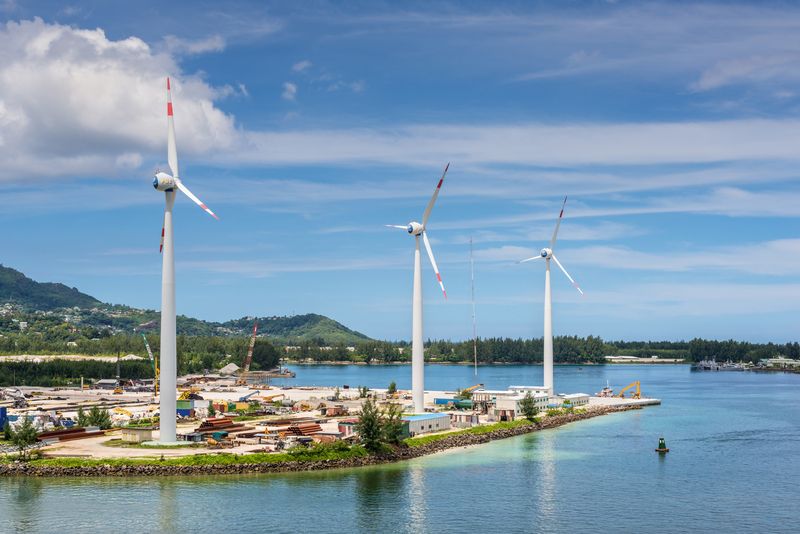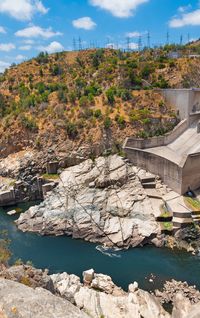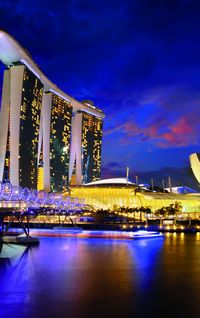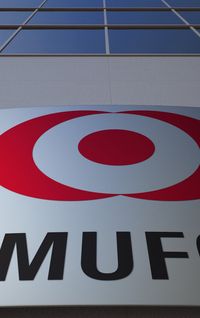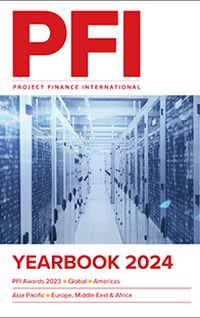Bank of the Year – Santander
Santander has been a green financing leader worldwide this year, especially in its motherland Europe – where it has been spotted in nearly every country with private developers pushing towards net-zero.
The bank was MLA on 130 deals globally in the first 10 months of 2023, of which 67 were in Europe only. Global debt financing provided in 2023 has topped US$13bn and over US$6bn has been poured into European project finance. In Europe alone, 36 deals have been signed specifically for renewables financing out of 60 renewables deals globally this year, lending over US$5bn worldwide and US$3.1bn to projects in European markets.
Santander’s 200-strong project finance global team is led by Benoit Felix from the bank’s global hub based in Madrid. The group branches out to 14 local offices across the world, with four key hubs in Europe including Madrid, London, Lisbon and Warsaw. Six offices are spread across northern, central and southern America and the Asia-Pacific activities are controlled from the Hong Kong hub.
Santander has proven its expertise in proposing value-added debt structuring advisories, helping sponsors to design optimal capital structures. The bank also takes advantage of its blended local and global expertise and presence and has a strong track record of cross-border deals and successes in both its core countries and in new markets.
It was MLA, green loan coordinator and hedge provider on the €800m debt financing for the Envision project in France, the country’s first EV battery gigafactory. Santander was active bookrunner, underwriter and MLA on the €6.98bn financing lined up for KKR and GIP to back their acquisition of Germany’s Vantage Towers from Vodafone. It supported Brookfield and DigitalBridge in the €6.8bn acquisition financing of a 51% stake in GD Towers in Germany, acting as underwriter and bookrunners. And it was sole financial adviser, MLA and green structuring bank on the largest debt raising by a privately-owned CPO globally, the £326m loan arrangement for Project Piazza in the UK, which is the largest EV infra financing in the UK to date.
Outside of the European geography, it acted as coordinating lead arranger and syndication agent on the US$10.8bn Rio Grande LNG construction financing for NextDecade in the US. And it was lead bank on Venture Global LNG’s phase two upsizing of the Plaquemines project in the US, for which US$7.2bn of debt was mobilised. It also backed the expansion of Lines 8 and 9 of the Sao Paulo Metro Network via PPP, acting as sole financial adviser on a R$4.6bn deal.
The bank has been investing in new technologies and assets including gigafactories, EV charging and green hydrogen. It’s new and strategic for both US and Europe and a key part of the energy transition. It signed alliances with Mazda and Tesla this year to be the exclusive financial arm of both car companies. The bank has performed exceptionally against the challenging macro environment, which has directly impacted project financing activity globally this year, including high interest rates, inflation, and supply chain disruption.
Deal of the Year – Baltic Power
The Polish-Canadian duo of Orlen and Northland Power was the only team to close Polish offshore wind financing on schedule, securing a €4.4bn non-recourse project financing package in September from a club of 25 lenders. The debt includes €3.6bn of term loan facilities and €800m of ancillary facilities for the 1.14GW Baltic Power offshore wind scheme. The debt package was a joint effort of 20 commercial banks, both Polish and international, two multilaterals –the EIB and EBRD – and three export credit agencies – Export Development Canada (EDC), Export and Investment Fund for Denmark (EIFO), and Germany’s Euler Hermes.
The financing was provided by BayernLB, HSBC, Bank Gospodarstwa Krajowego, BNP Paribas, Credit Agricole, Caixa, CIBC, DNB, EDC, EIB, EBRD, Erste, Helaba, KfW IPEX, ING, National Bank of Canada, Bank Pekao, PKO Bank Polski, Rabobank, Santander, SMBC, Societe Generale and Standard Chartered as lenders providing funding, plus EIFO and Euler Hermes as ECAs providing risk cover only. The equity and standby equity for the project is about €945m all-in. The uncovered term loan tranche is €1.85bn and the rest is ECA-covered.
The largest lenders in the commercial tranche were EDC with €250m of direct lending, the EIB with a €350m direct term project finance loan tranche, BGK with €260m, thanks to euro funding extended by the EIB on top of its €350m, EBRD with a €140m senior tranche, Credit Agricole, and Erste. Others recorded larger exposures under the covered tranches. The sponsors’ financial advisers were Green Giraffe Advisory and Pekao Investment Banking. The Green Giraffe team was led by Udo Schneider and Pekao was led by Monika Karolak. Hogan Lovells was legal adviser to the sponsors and Linklaters was legal adviser to the lenders. K2 Management was technical adviser on the deal.
The project is backed by a 25-year contract-for-difference, which is granted by law rather than as a private contract like in UK CfDs. The project’s original CfD was signed in 2021 for Z319.6/MWh (€69/MWh) and was subsequently 100% pegged to the euro at a €4.45/zloty rate, including an inflation indexation feature commencing with a base year of 2021. The indexation was originally calculated in line with the 2022 exchange rate and was later moved to match 2021 rates to counter rising costs. The initial plan had been to keep some 25% of the CfD in zloty and peg 75% to the euro, matching an expected 75:25 ratio of euro and zloty-denominated debt splits. Opting for the entire CfD to be pegged to euros significantly helped offset the increase in costs. Euro and zloty swap costs, for example, are 3% and 8% respectively.
The long-term indexation and 100% euro peg allowed for the rather low 5% cost of capital. The scheme features more than 10 different EPC contractors: Vestas, Cadeler, JBO, Steelwind, Smulders, Van Oord, Deme, NKT, TFKable, Bladt, Semco, General Electric, and Enprom. Baltic Power is the first offshore wind project finance transaction in Poland and the largest Polish project finance to date. It is also the biggest offshore wind project financing in the EU as deals that are bigger were only closed in the UK after Brexit. The deal also marks the first project financing of the new Vestas V236 15MW, at a time when the entire offshore wind industry is being hit by challenges and price increases linked to issues in the supply chain. Once operational, which is estimated to be in the middle of 2026, Baltic Power is expected to provide clean energy to more than 1.5m Polish households.
Industrial Deal of the Year – AESC Douai
Japan-headquartered battery manufacturer Automotive Energy Supply Corporation’s Douai gigafactory is the first of four announced electric vehicle battery factories in France to reach close as Europe looks to become the energy transition’s factory. AESC's €1.3bn factory is located at Renault’s Douai site in northern France and will have the capacity to produce 9GWh of batteries per year, with operations expected to begin in 2024.
Project SPV Envision AESC France raised a €986m debt package from commercial lenders and backed by the European Investment Bank and Chinese ECA Sinosure. AESC, formerly Envision AESC, is 80% owned by Chinese renewable energy company Envision Group.
Commercial banks BBVA, Santander, BNP Paribas, HSBC, Natixis and Societe Generale are lending a total €463.3m, including a €158.8m term loan covered by French public investment bank Bpifrance and a €165m term loan covered by Sinosure.
The debt package has a €100m uncovered working capital facility, a €20m uncovered VAT facility, and a €19.5m uncovered standby letter of credit facility. Both the Bpifrance and Sinosure-backed term loans have 3.5-year grace periods and are amortising. The standby letter of credit is amortising but has no grace period, and the working capital and VAT facilities have bullet repayments.
The EIB’s €450m funding comprises a €317.7m term loan and €19.5m standby loan, both direct lending – and €112.8m of indirect funding support to commercial banks, improving their terms. All of the debt is senior bar a final €73m piece of subordinated, mezzanine debt from Caisse des Depots et Consignations (CDC) unit Banque des Territoires.
The deal is banked on the gigafactory’s cashflow backed by Renault’s agreement to offtake 100% of production over 5.75 years from the start of production in 2025, under a take-or-pay contract.
Renault’s offtake is shorter than the 11.5-year tenor on the term loans and a cash sweep will kick in once the project begins operating to compensate for this. The sweep will be lifted if AESC renews the contract with Renault. The VAT facility has a four-year tenor. The gigafactory can be expanded in a modular approach up to a total capacity of 30GWh.
AESC received financial advice from Societe Generale and legal advice from Allen & Overy. The lenders were advised by Linklaters, DLA Piper, and Milbank. The transaction paves the way for several other developments that AESC is lining up. The company is looking to build gigafactories in Kentucky in the US, Ibaraki in Japan, Extremadura in Spain, and Sunderland in the UK.
Sustainability Deal of the Year – H2 Green Steel
Swedish low-carbon steel producer H2 Green Steel (H2GS) completed a €1.5bn equity raising, one of the final pieces of the more than €5bn financial puzzle that will enable construction of its green steel production plant in Boden.
The equity round was co-led by new investor Hy24 and existing investors Altor, GIC and Just Climate. New investors Andra AP-fonden and Temasek joined existing investors AMF, Hitachi Energy, IKEA-related IMAS Foundation, Kinnevik, Schaeffler, Vargas, Wallenberg Investments holding company FAM, Kobe Steel, Swedbank Robur Alternative Equity, Kingspan Global, and Marcegaglia, as well as Cristina Stenbeck and Daniel Ek, co-founder of music streaming service Spotify.
Morgan Stanley is advising the sponsor on the equity side. H2GS is overall raising some €5bn for its direct reduced iron plant. French bank Societe Generale is leading the SKr38bn (€3.44bn) debt package backing the steel mill and is working with German development finance institution KfW IPEX-Bank as co-adviser. H2GS aims to ink the debt package before the end of 2023.
The company has raised conditional financing commitments for most of the package via senior debt from Svensk Exportkredit and commercial banks BNP Paribas, ING, UniCredit, Societe Generale and KfW IPEX-Bank. The European Investment Bank’s board has approved €640m of senior debt financing for the project.
The package amounts to about €3bn of senior debt plus a €500m slice of junior debt with €1.3bn of export credit guarantees through agencies including Germany’s Euler Hermes, the UK’s UKEF, and Norway’s Eksfin. Allen & Overy is advising the lenders.
The state-run Swedish National Debt Office (Riksgalden) is providing a green credit guarantee for up to 80% of about €1bn – equivalent to SKr11bn. Riksgalden provides its green credit guarantee contingent on the investments meeting certain environmental requirements. The debt tenor will be more than 10 years, H2GS’ CFO Otto Gernandt said previously – which is broadly in line with ECA terms of construction plus about 10 years.
H2GS in 2022 announced the structure for its debt financing and renewed commitment letters in July 2023. Since being launched in 2021, H2GS has raised more than €1.8bn of equity in three financing rounds. The company closed its €86m Series A equity round in May 2021 and announced the close of its €260m Series B1 round in October 2022.
The steel plant will be powered by hydrogen produced from 690MW of electrolysers powered by renewable energy. Traditional blast furnaces using coal and coke produce about two tonnes of CO2 per produced tonne of steel. In comparison, H2GS’s direct reduced iron production process aims to reduce emissions by up to 1,900kg per tonne of finished steel.
H2GS hasn’t disclosed how it will price its steel, although the company is confident of competitive pricing. It expects to deliver zero-carbon steel priced at a premium of around 10%–20% over standard steel, Gernandt said previously. Commercial volumes are expected from 2025 and production of 5m tonnes is expected by 2030.
A wide mix of customers have signed term sheets or supply agreements with H2GS, including Adient, BE Group, Bilstein Group, BMW, Electrolux, Kingspan, Klockner & Co, Lindab, Marcegaglia, Mercedes-Benz, Miele, Mubea, Purmo Group, Roba Metals, Scania, Schaeffler, Zekelman Industries and ZF Group.
H2GS’ founding shareholder Vargas is also co-founder and one of the largest shareholders of Swedish battery company Northvolt. H2GS and Northvolt have the same chairman, Carl-Erik Lagercrantz.
Power Deal of the Year – Moray West
At a time of rising interest rates and construction costs, raising funds for a £2.5bn project would be challenging enough. But with the Moray West offshore wind farm there was the added complexity of an innovative revenue stack. Unlike previous large-scale offshore wind farms in the UK, the contract for difference (CfD) revenue stream only covers 33% of the project’s 882MW power output, with the rest being taken up by new tech companies Google, with 100MW for 12 years, and Amazon, with 473MW for 15 years.
The variable revenue streams available to the project introduced complexities in the financing structure and required the development of various documentary mechanics to achieve a bankable process for debt sizing. On top of this, the deal needed a strong construction story. The project will be the first to utilise Siemens Gamesa 14.7MW offshore turbines and the sponsors are planning a rapid deployment of first power in 2024. Other construction contracts were said to be very competitive in the current marketplace leading necessary due diligence. There are 12 main construction contracts.
The scheme is backed by a 15 year contract for difference (CfD) for 249MW at £37.35/MWh awarded last summer plus the two corporate power purchase agreements (CPPAs) with the rest being merchant in the nose and tail periods of the scheme.
The scheme was put together by Ocean Winds, the EDPR and Engie joint venture. Lithuanian group Ignitis Renewables took a 5% stake in the scheme in 2020 to gain experience in offshore wind project development. The £1.85bn of 20-year debt was provided by 20 banks priced around the 150bp–160bp mark, with Norwegian export credit agency Eksfin guaranteeing £155m, half of the offshore transmission owner (OFTO) element of the package. The contracted debt service cover ratio is (DSCR) is 1.25x and the merchant DSCR is 1.5x–1.7x, in each case at P90 15-year.
Credit Agricole and Norton Rose Fulbright advised the sponsors and Ashurst advised the lenders. Burness Paull and Shepherd & Wedderburn were the Scottish counsel. The banks on the deal are AIB, Bank of China, Barclays, BBVA, BNP Paribas, CIBC, Caixabank, CIC, Commerzbank, Credit Agricole, HSBC, KBC, Lloyds, MUFG, Mizuho, NatWest, Siemens Bank, Societe Generale, Standard Chartered and SMBC.
Renewables Deal of the Year – Bruc Energy
Spanish renewables investor and asset manager Bruc Energy raised a €600m corporate financing backing construction of 6GW of hybridised wind and solar capacity across Spain and Italy. The financing was raised at the holdco level with the proceeds to be pushed down to finance the base equity of the projects at the opco level. It was sized at about 35% loan-to-value and secured at the borrower level and structurally subordinated to the project finance debt of the assets below.
The package consists of a €350m five-year term loan and letter of credit facility provided by banks alongside a €250m seven-year term loan from institutional investors. Underwriters and MLAs were BNP Paribas, Banco Santander, Instituto de Crédito Oficial, Intesa Sanpaolo, and ING. MLAs on the institutional side were Schroders Capital and Infranity. BNP Paribas was hedge provider and Santander was agent bank.
The portfolio of assets is approximately 90% located in Spain with the rest in Italy. Bruc targets at least 70% of volumes contracted in the next five years on a rolling basis. Bruc Energy received financial advice from Astris Finance and legal advice from Allen & Overy. The lenders were supported by law firm Linklaters. Deal signing and close took place on August 8.
Bruc Energy is an investment branch of Bruc Management and has about 1.1GW of solar capacity either operating or at advanced stages of construction. Interogo Holding’s infrastructure investment fund Inter Infrastructure Capital (IIC) in June agreed to take a 49% stake in that portion of the portfolio. Bruc Energy’s assets are located in Spain and Japan, with 8.6GW of wind and solar in the pipeline for the Iberian Peninsula and 100MW under management in Japan. Bruc is also developing several renewable energy storage projects.
Bruc Energy is led by CEO Luis Venero CEO. The company was co-founded by Spanish businessman Juan Béjar, CEO of Bruc Management, and Canadian pension fund OPTrust. Its other shareholders include UK pension fund Universities Superannuation Scheme with a 50% stake acquired in mid-2021. Bejar holds a sub-5% stake in the energy platform.
EV Deal of the Year – Gridserve
The electric vehicle (EV) infrastructure sector is one of the exciting new arenas that project financiers are turning their hands to, and in Gridserve the sector reached a critical financing size. The Infracapital-backed company raised £326m in project debt plus a £200m accordion to back its sun-to-wheel EV charging network across the UK in the first commercially sized financing.
The company raised £200m in equity from Infracapital in 2022 to bring it alongside existing investor TPG Rise. The debt and equity financing combined will allow Gridserve to expand its network by 3,000 chargers from its existing 600. In addition, Gridserve sources it own solar energy and the financing will fund new solar projects via the accordion, focusing on schemes in the 5MW range. Gridserve has been linking up with retailers with good grid access to site its chargers and is developing its own electric forecourts.
The debt raised is structured as a four to five-year deal that can be refinanced once the assets become operational. Banks derived comfort from the performance of the existing chargers but clearly this is still an evolving market, although there is plenty of demand growth, making the deal a challenge.
Added to this was the fact that during the time the financing was put together base rates jumped by 300bp. But demand for the loan was said to be high, given it was initially sized at £150m, and the deal could have been even larger if interest rates had not increased. The £326m facility consists of a £300m term loan, a £10m working capital facility and a £16m VAT facility with a first disbursement of £150m.
Gridserve was set up by Toddington Harper. Former project financier Mark Henderson is the chief investment officer.
Santander was the financial adviser on the deal and the other banks joining are CIBC, KfW IPEX, Lloyds Bank, MUFG, Natixis, NatWest and UK Infrastructure Bank. Gridserve was advised by Clifford Chance, legal, Arup, commercial, PwC, tax and financial, Aon, insurance, and Mazars, model audit, while lenders were advised by Latham & Watkins, legal, Lloyds as facility agent and security bank, and Natixis as hedging coordinator.
Digital Deal of the Year – GD Towers
Brookfield and DigitalBridge acquired a 51% stake in Deutsche Telekom’s German and Austrian towers business, GD Towers, backing the acquisition with a €6.85bn debt package. GD Towers is Germany`s largest tower company, owning and operating more than 33,000 towers and communication sites in Germany and over 7,000 in Austria. Its portfolio of assets is backed by long-term, approximately 30-year, anchor tenancy agreements in place with Deutsche Telekom-owned subsidiaries Telekom Deutschland and T-Mobile Austria.
The €6.85bn seven-year senior debt is split into €1.65bn junior holdco and €5.2bn senior opco packages, both consisting of term loan and revolving credit facilities. The opco piece also features a capex facility. Brookfield and DigitalBridge each hold 50% in holdco Salsa Holding, which is ultimately acquiring the asset. The opco is DFMG Holding. BNP Paribas, Credit Agricole, Intesa Sanpaolo, MUFG, Natixis, Santander and UniCredit led and underwrote the opco and holdco financings, with tickets of approximately €979m each.
The debt was then syndicated, with LBBW, Mizuho and Toronto-Dominion in both the opco and holdco packages. ABN, ANZ, Aviva, AXA, Banco Sabadell, BBVA, Caixa, CIC, DWS, Erste, Helaba, KDB, KfW, La Banque Postale AM, NIMI, Shinhan, and Standard Chartered joined the opco only. The holdco was joined by Allianz, Blackrock, CDPQ, F2i, Generali, Samsung Life, Schroders, and Westbourne.
Deutsche Telekom received €10.7bn from the sale, giving GD Towers an enterprise value of €17.5bn. Deutsche Telekom and subsidiary Magenta Austria will continue to have unrestricted access to GD Towers' passive infrastructure via long-term lease agreements. The deal is priced at a 27x earnings multiple. DigitalBridge and Brookfield received financial advice from Perella Weinberg Partners, Evercore, and Barclays. They received legal advice from Allen & Overy, Morgan Lewis & Bockius, CMS Luxembourg, Dorda Brugger & Jordis, Schoenherr Attorney's at Law, and Weil Gotshal & Manges.
Deutsche Telekom was advised by Goldman Sachs and law firm Gleiss Lutz, P+P Poellath + Partners, Noerr Partnerschaftsgesellschaft, and Freshfields Bruckhaus Deringer. The lenders were advised by law firm White & Case. Deal close took place in February and Deutsche Telekom retained the minority 49% stake in GD Towers, which was established as a spin-off from parent Deutsche Telekom in 2002.
To see the digital version of this report, please click here.
To purchase printed copies or a PDF of this report, please email leonie.welss@lseg.com
